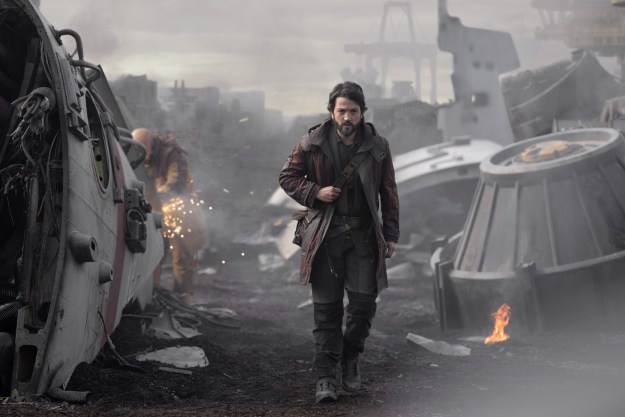The Mandalorian has always wanted to have its cake and eat it, too. Across its first two seasons, the series attempted to blend sidequest-heavy, episodic storytelling with one longform, serialized story. While the show never found the perfect balance between those two modes, its first two seasons both came together well in the end. Unfortunately, The Mandalorian season 3 hasn’t been quite as effective.
Over the course of its first six episodes, The Mandalorian’s latest season has struggled to maintain any kind of singular, serialized story. Instead, it has delivered a handful of sidequests and one-note villains that so far haven’t amounted to much. Along the way, the series has loosely threaded together its latest batch of adventures with a story about Bo-Katan Kryze (Katee Sackhoff) and Din Djarin (Pedro Pascal) setting out to retake Mandalore, which has progressed at a frustratingly uneven pace.
All of these problems, along with the show’s inability to balance Bo-Katan and Din Djarin’s perspectives, have resulted in a season of television that feels disappointingly directionless. In fact, it’s starting to feel like The Mandalorian doesn’t really know how or what story it wants to tell anymore.
The Mandalorian’s identity crisis

The Mandalorian used to be about Din Djarin and his force-sensitive ward, Grogu. The former character started out as a detached, cold bounty hunter who had little interest in personal connection. That all changed when he met Grogu. Across its first two seasons, The Mandalorian consequently followed Din as he grew so close to Grogu that he not only became a more sensitive friend and formidable warrior, but also a father figure who was willing to reevaluate his own beliefs in order to protect his loved ones.
Din’s journey set him up to be — like so many of the iconic heroes who have come before him — an unlikely, but capable leader. In its third season, however, The Mandalorian has more or less thrown that possibility out the window. Not only has Din reverted back to following the laws of The Way with a dogmatic fierceness, but his and Grogu’s relationship hasn’t evolved or progressed at all since the last time Star Wars fans saw them together at the end of The Book of Boba Fett season 1.
Instead of continuing to find new ways to challenge Din and Grogu’s relationship, The Mandalorian has turned its attention to Bo-Katan and Din’s shared desire to rebuild Mandalore. On paper, that makes sense as the next chapter of The Mandalorian’s story. However, in practice, the series’ Bo-Katan-centric plot has left a lot to be desired.
The problem with Bo-Katan

Over the course of The Mandalorian season 3, Bo-Katan has gone from an exiled princess living in isolation to the newly decreed future leader of Mandalore. The only problem with that arc is that Bo-Katan herself hasn’t actually changed in ways that justify such a transformation. She has more or less remained the same person she was when she first showed up on The Mandalorian. Even when it looked like the Disney+ series was going to see her become a full-time, card-carrying follower of The Way, The Mandalorian ended up abandoning that possibility.
Now, Bo-Katan has not only been given permission by The Armorer (Emily Swallow) and the other members of Din’s covert to take her helmet off in the presence of others, but she’s also been named the new wielder of the Darksaber by Din himself. Despite Din’s fierce belief in her, though, The Mandalorian hasn’t sufficiently shown or explained why Bo-Katan deserves to take his place as the future leader of Mandalore. In fact, while viewers have already witnessed Din’s capacity for change, Bo-Katan hasn’t grown much since she appeared for the first time in The Mandalorian season 2.
As a result, many moments in The Mandalorian season 3 have felt like the series just going through the motions. The show’s previously established emotional throughlines have either been sidelined or abandoned altogether — leaving The Mandalorian with only a series of plot developments that carry little actual weight.
Too much of a good thing?

One of the biggest problems with franchise storytelling, in general, is that it can lead to certain series overstaying their welcome. That usually happens whenever a show keeps going after its central dramatic argument has already been resolved, which is just another way of saying that it no longer has any reason to exist outside of its own corporate worth.
It’s starting to feel more and more like that’s what has happened to The Mandalorian. In previous years, the Disney+ series was kept afloat by Din and Grogu’s relationship, which allowed it to explore the ways that connection and love can motivate a person to grow and become a better version of themselves. For comparison’s sake, Season 1 of Andor similarly used one man’s political radicalization to tell a story about how hope and freedom can thrive in even the most oppressive of times. Unfortunately, The Mandalorian seems to believe that it ran out of ways to explore its core themes when it reunited Din and Grogu in The Book of Boba Fett.
All that remains in the show is Bo-Katan and Din Djarin’s shared mission to rebuild Mandalore. To be fair, that’s an objectively intriguing premise, but The Mandalorian season 3 has failed to establish an actual story beneath that plot. The series, in other words, has become a zero-calorie space odyssey that is in desperate need of something deeper and greater to latch onto.
New episodes of The Mandalorian premiere Wednesdays on Disney+.
Editors' Recommendations
- Disney+ reveals the first trailer for Star Wars: Tales of the Empire
- Combined Disney+/Hulu app to launch in beta in December
- Did Andor ruin Ahsoka, and maybe the entire Star Wars franchise, by being too good?
- Disney already knows if you’re sharing your streaming account
- Disney+, Hulu, ESPN+ get new pricing schemes this fall




